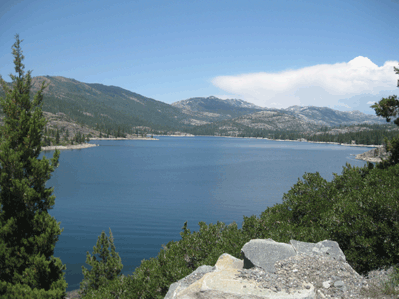Federal Energy Regulatory Commission (FERC) Project No. 14796
Project Name: Mokelumne Pumped Storage Project
 Salt Springs Reservoir
Salt Springs Reservoir(Image from GreenGen’s Mokelumne Pumped Storage
Project Final License Application)
Applicant: GreenGenStorage, LLC (GreenGen)
Counties: Amador and Calaveras
Water Quality Certification Status: not yet received
Waterbodies: Mokelumne River, Bear River, Lower Bear River Reservoir, Salt Springs Reservoir
FERC Licensing Process:Integrated Licensing Process
Project Description:
The Mokelumne Pumped Storage Project (Project), Federal Energy Regulatory Commission (FERC) No. P-14796, is proposed by GreenGenStorage, LLC (GreenGen) in the Mokelumne River watershed. The Project proposes a new 400-megawatt (MW) pumped storage hydroelectric facility located near the city of Jackson in Amador and Calaveras Counties. The Project would utilize the existing Salt Springs Reservoir (SSR) (located on the North Fork Mokelumne River) and the Lower Bear River Reservoir (LBRR) (located on the Bear River). SSR and LBRR are owned and operated as part of Pacific Gas & Electric Company’s (PG&E’s) Mokelumne River Hydroelectric Project (FERC No. P-137). The Project would generate by conveying water from LBRR to SSR and would store energy by pumping water from Salt Springs Reservoir to LBRR. The Project would encompass 75.3 acres of land owned by the Eldorado National Forest and PG&E.
The Project would consist of: an upper reservoir submerged intake/outlet (I/O) riser lake tap within LBRR; a gate shaft and gatehouse located approximately 1,700 ft (0.3 miles) southeast of the LBRR lake tap, sited within a rock outcrop alongside the shore of LBRR. The gate shaft would be 40-ft diameter and have a depth of 280 ft to Tunnel No. 1. The gatehouse containing the hydraulic cylinder and gate operating equipment would be located 30 feet below grade, accessible being stairwell located on the ground surface. A low-pressure 22- foot-diameter headrace tunnel (Tunnel No. 1) extending 10,700 feet from the intake to the pressure shaft which would contain a fixed wheel gate for closure; a 22-foot-diameter, 1560-foot-long pressure shaft with a 30-foot-diameter, 550-foot-long surge shaft daylighting on the surface; a pressurized 22-foot-diameter tunnel (Tunnel No. 2) extending 4,700 feet from the pressure shaft to the subterranean powerhouse; a subterranean powerhouse cavern containing two identical variable speed Francis-type reversible pump-turbines, each coupled with a 200 MW synchronous motor-generator; and a spare bay for the potential installation of a third unit in the future; a tailrace tunnel (Tunnel No. 3) connects the draft tubes of each pump-turbine to the I/O lake tap within SSR which would contain an isolation valve cavern; a 230-kilovolt (kV) switchyard serving as the point of interconnection with the existing Salt Springs substation; a 30-foot-diameter, 3,900-foot-long access tunnel to the powerhouse cavern, the upper and lower gate shafts, and the surge shaft facilities; and an 18-foot-diameter, 4,100-foot-long utility tunnel to transmit power to and from the surface switchyard providing a secondary exit from the facility and ventilation.
Related Documents
FERC
- State Water Board comments on Pre-Application Document - Aug. 8, 2022
- State Water Board comments on Draft License Application - Nov. 27, 2024


